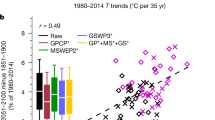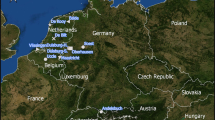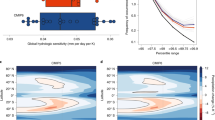Abstract
Environmental phenomena are often observed first, and then explained quantitatively. The complexity of processes, the range of scales involved, and the lack of first principles make it challenging to predict conditions beyond the ones observed. Here we use the intensification of heavy precipitation as a counterexample, where seemingly complex and potentially computationally intractable processes manifest themselves to first order in simple ways: heavy precipitation intensification is now emerging in the observed record across many regions of the world, confirming both theory and model predictions made decades ago. As the anthropogenic climate signal strengthens, there will be more opportunities to test climate predictions for other variables against observations and across a hierarchy of different models and theoretical concepts.
This is a preview of subscription content, access via your institution
Access options
Subscribe to this journal
Receive 12 print issues and online access
$209.00 per year
only $17.42 per issue
Buy this article
- Purchase on Springer Link
- Instant access to full article PDF
Prices may be subject to local taxes which are calculated during checkout


Similar content being viewed by others
References
Trenberth, K. E. Conceptual framework for changes of extremes of the hydrological cycle with climate change. Climatic Change 42, 327–339 (1999).
Hennessy, K. J., Gregory, J. M. & Mitchell, J. F. B. Changes in daily precipitation under enhanced greenhouse conditions. Clim. Dynam. 13, 667–680 (1997).
Schmidt, G. A., Shindell, D. T. & Tsigaridis, K. Reconciling warming trends. Nat. Geosci. 7, 158–160 (2014).
Huber, M. & Knutti, R. Natural variability, radiative forcing and climate response in the recent hiatus reconciled. Nat. Geosci. 7, 651–656 (2014).
Clapeyron, E. Mémoire sur la puissance motrice de la chaleur. J. l'École Polytechnique XXIIIe Cahier, Tome XIV 153–191 (1834).
Clausius, R. Über die bewegende kraft der wärme und die gesetze, welche sich daraus für die wärmelehre selbst ableiten lassen. Ann. Phys. (Berlin) 155, 368–397 (1850).
Manabe, S. & Wetherald, R. T. The effects of doubling the CO2 concentration on the climate of a General Circulation Model. J. Atmos. Sci. 32, 3–15 (1975).
Noda, A. & Tokioka, T. The effect of doubling the CO2 concentration on convective and non-convective precipitation in a general-circulation model coupled with a simple mixed layer ocean model. J. Meteor. Soc. Japan 67, 1057–1069 (1989).
Fowler, A. M. & Hennessy, K. J. Potential impacts of global warming on the frequency and magnitude of heavy precipitation. Natural Hazards 11, 283–303 (1995).
Gordon, H. B., Whetton, P. H., Pittock, A. B., Fowler, A. M. & Haylock, M. R. Simulated changes in daily rainfall intensity due to the enhanced greenhouse effect: implications for extreme rainfall events. Clim. Dynam. 8, 83–102 (1992).
Whetton, P. H., Fowler, A. M., Haylock, M. R. & Pittock, A. B. Implications of climate change due to the enhanced greenhouse effect on floods and droughts in Australia. Climatic Change 25, 289–317 (1993).
Taylor, K. E., Stouffer, R. J. & Meehl, G. A. An overview of CMIP5 and the experiment design. Bull. Am. Meteorol. Soc. 93, 485–498 (2012).
Hansen. J. et al. Global climate changes as forecast by Goddard Institute for space studies 3-dimensional model. J. Geophys. Res. Atmos. 93, 9341–9364 (1988).
Wetherald, R. T. & Manabe, S. Cloud feedback processes in a general-circulation model. J. Atmos. Sci. 45, 1397–1415 (1988).
Iwashima, T. & Yamamoto, R. A statistical analysis of the extreme events: long-term trend of heavy daily precipitation. J. Meteor. Soc. Japan. 71, 637–640 (1993).
IPCC Climate Change 1995: The Science of Climate Change (eds Houghton, J. T. et al.) (Cambridge Univ. Press, 1996).
Hartmann, D. L. et al. in Climate Change 2013: The Physical Science Basis (eds Stocker, T. F. et al.) Ch. 2 (IPCC, Cambridge Univ. Press, 2014).
Alexander, L. V. Global observed long-term changes in temperature and precipitation extremes: a review of progress and limitations in IPCC assessments and beyond. Weather Clim. Extremes 11, 4–16 (2016).
Kunkel, K. E. & Frankson, R. M. Global land surface extremes of precipitation: data limitations and trends. J. Extreme Events 2, 1550004 (2015).
Westra. S., Alexander, L. V. & Zwiers, F. W. Global increasing trends in annual maximum daily precipitation. J. Clim. 26, 3904–3918 (2013).
Donat, M. G., Lowry, A. L., Alexander, L. V., O'Gorman, P. A. & Maher N. More extreme precipitation in the world's dry and wet regions. Nat. Clim. Change 6, 508–513 (2016).
Haylock, M. R. et al. A European daily high-resolution gridded data set of surface temperature and precipitation for 1950–2006. J. Geophys. Res. Atmos. 113, D20119 (2008).
Fischer, E. M. & Knutti, R. Anthropogenic contribution to global occurrence of heavy-precipitation and high-temperature extremes. Nat. Clim. Change 5, 560–564 (2015).
Jones, C., Giorgi, F. & Asrar, G. The coordinated regional downscaling experiment: CORDEX–an international downscaling link to CMIP5. Clivar Exchanges 16, 34–40 (2011).
Kotlarski, S. et al. Regional climate modeling on European scales: a joint standard evaluation of the EURO-CORDEX RCM ensemble. Geosci. Model Dev. 7, 1297–1333 (2014).
Min, S.-K., Zhang, X., Zwiers, F. W. & Hegerl, G. C. Human contribution to more-intense precipitation extremes. Nature 470, 378–381 (2011).
Zhang, X., Wan, H., Zwiers, F. W., Hegerl, G. C. & Min, S.-K. Attributing intensification of precipitation extremes to human influence. Geophys. Res. Lett. 40, 5252–5257 (2013).
Fischer, E. M. & Knutti, R. Detection of spatially aggregated changes in temperature and precipitation extremes. Geophys. Res. Lett. 41, 547–554 (2014).
Kopparla, P., Fischer, E. M., Hannay, C. & Knutti, R. Improved simulation of extreme precipitation in a high-resolution atmosphere model. Geophys. Res. Lett. 40, 5803–5808 (2013).
Rajczak, J., Pall, P. & Schär, C. Projections of extreme precipitation events in regional climate simulations for Europe and the Alpine region. J. Geophys. Res. Atmos. 118, 3610–3626 (2013).
Giorgi, F. et al. Enhanced summer convective rainfall at Alpine high elevations in response to climate warming. Nat. Geosci. 9, 584–589 (2016).
Westra, S. & Sisson, S. A. Detection of non-stationarity in precipitation extremes using a max-stable process model. J. Hydrol. 406, 119–128 (2011).
Utsumi, N., Seto, S., Kanae, S., Maeda, E. E. & Oki, T. Does higher surface temperature intensify extreme precipitation? Geophys. Res. Lett. 38, L16708 (2011).
O'Gorman, P. A. Sensitivity of tropical precipitation extremes to climate change. Nat. Geosci. 5, 697–700 (2012).
Catto, J. L. & Pfahl, S. The importance of fronts for extreme precipitation. J. Geophys. Res. Atmos. 118, 10791–10801 (2013).
Pfahl, S. & Wernli, H. Quantifying the relevance of cyclones for precipitation extremes. J. Clim. 25, 6770–6780 (2012).
Schaller, N. et al. Human influence on climate in the 2014 southern England winter floods and their impacts. Nat. Clim. Change 6, 627–634 (2016).
Pendergrass, A. G. & Hartmann, D. L. Two modes of change of the distribution of rain. J. Clim. 27, 8357–8371 (2014).
Pendergrass, A. G. & Hartmann, D. L. Changes in the distribution of rain frequency and intensity in response to global warming. J. Clim. 27, 8372–8383 (2014).
O'Gorman, P. A. & Schneider, T. The physical basis for increases in precipitation extremes in simulations of 21st-century climate change. Proc. Natl Acad. Sci. USA 106, 14773–14777 (2009).
Kharin, V., Zwiers, F., Zhang, X. & Wehner, M. Changes in temperature and precipitation extremes in the CMIP5 ensemble. Climatic Change 119, 345–357 (2013).
Fischer, E. M., Sedlacek, J., Hawkins, E. & Knutti, R. Models agree on forced response pattern of precipitation and temperature extremes. Geophys. Res. Lett. 41, 8554–8562 (2014).
O'Gorman, P. A. & Schneider, T. Scaling of precipitation extremes over a wide range of climates simulated with an idealized GCM. J. Clim. 22, 5676–5685 (2009).
O'Gorman, P. A. Precipitation extremes under climate change. Curr. Clim. Change Rep. 1, 49–59 (2015).
Trenberth, K. E., Dai, A., Rasmussen, R. M. & Parsons, D. B. The changing character of precipitation. Bull. Am. Meteorol. Soc. 84, 1205–1217 (2003).
Allan, R. & Soden, B. Atmospheric warming and the amplification of precipitation extremes. Science 321, 1481–1484 (2008).
Frei, C., Schär, C., Lüthi, D. & Davies, H. C. Heavy precipitation processes in a warmer climate. Geophys. Res. Lett. 25, 1431–1434 (1998).
Chavaillaz, Y., Joussaume, S., Bony, S. & Braconnot, P. Spatial stabilization and intensification of moistening and drying rate patterns under future climate change. Clim. Dynam. 47, 951–965 (2015).
Pendergrass, A. G., Lehner, F., Sanderson, B. M. & Xu, Y. Does extreme precipitation intensity depend on the emissions scenario? Geophys. Res. Lett. 42, 8767–8774 (2015).
Lenderink, G. & Attema, J. A simple scaling approach to produce climate scenarios of local precipitation extremes for the Netherlands. Environ. Res. Lett. 085001 (2015).
Rajczak. J., Pall, P. & Schär, C. Projections of extreme precipitation events in regional climate simulations for Europe and the Alpine Region. J. Geophys. Res. Atmos. 118, 3610–3626 (2013).
Kendon, E. J. et al. Heavier summer downpours with climate change revealed by weather forecast resolution model. Nat. Clim. Change 4, 570–576 (2014).
Lenderink, G. & van Meijgaard, E. Increase in hourly precipitation extremes beyond expectations from temperature changes. Nat. Geosci. 1, 511–514 (2008).
Westra, S. et al. Future changes to the intensity and frequency of short-duration extreme rainfall. Rev. Geophys. 52, 522–555 (2014).
Berg, P., Moseley, C. & Haerter, J. O. Strong increase in convective precipitation in response to higher temperatures. Nat. Geosci. 6, 181–185 (2013).
Lenderink, G. et al. Preparing local climate change scenarios for the Netherlands using resampling of climate model output. Environ. Res. Lett. 115008 (2014).
Zwiers, F. W. et al. in Climate Science for Serving Society (eds Asrar, G. R. & Hurrell, J. W.) Ch. 13, 339–389 (Springer, 2013).
Shepherd, T. G. A common framework for approaches to extreme event attribution. Curr. Clim. Change Rep. 2, 28–38 (2016).
Trenberth, K. E., Fasullo, J. T. & Shepherd, T.G. Attribution of climate extreme events. Nat. Clim. Change 5, 725–730 (2015).
Martius, O. et al. The role of upper-level dynamics and surface processes for the Pakistan flood of July 2010. Q. J. Roy. Meteorol. Soc. 139, 1780–1797 (2013).
Prein, A. F. et al. A review on regional convection-permitting climate modeling: demonstrations, prospects, and challenges. Rev. Geophys. 53, 323–361 (2015).
Chan, S. C., Kendon, E. J., Fowler, H. J., Blenkinsop, S. & Roberts, N. M. Projected increases in summer and winter UK sub-daily precipitation extremes from high-resolution regional climate models. Environ. Res. Lett. 9, 084019 (2014).
Chan, S. C., Kendon, E. J., Roberts, N. M., Fowler, H. J. & Blenkinsop, S. Downturn in scaling of UK extreme rainfall with temperature for future hottest days. Nat. Geosci. 9, 24–28 (2015).
Ban, N., Schmidli, J. & Schär, C. Heavy precipitation in a changing climate: does short-term summer precipitation increase faster? Geophys. Res. Lett. 42, 1165–1172 (2015).
IPCC Climate Change 2013: The Physical Science Basis (eds Stocker, T. F. et al.) (Cambridge Univ. Press, 2014).
Knutti, R., Masson, D. & Gettelman, A. Climate model genealogy: generation CMIP5 and how we got there. Geophys. Res. Lett. 40, 1194–1199 (2013).
Knutti, R. & Sedlacek, J. Robustness and uncertainties in the new CMIP5 climate model projections. Nat. Clim. Change 3, 369–373 (2013).
Knutti, R. The end of model democracy? Climatic Change 102, 395–404 (2010).
Arrhenius, S. On the influence of carbonic acid in the air upon the temperature of the ground. London Edinburgh Dublin Phil. Mag. J. Sci. 41, 237–276 (1896).
Hansen, J. et al. in Climate Processes and Climate Sensitivity (eds Hansen, J. E. & Takahash, T.) 130–163 (AGU Geophysical Monograph, 1984).
Bindoff, N. L. et al. in Climate Change 2013: The Physical Science Basis (eds Stocker, T. F. et al.) Ch. 10 (IPCC, Cambridge Univ. Press, 2014).
Hansen, J. et al. Climate impact of increasing atmospheric carbon dioxide. Science 213, 957–966 (1981).
Hansen, J. et al. Climate response times: dependence on climate sensitivity and ocean mixing. Science 229, 857–859 (1985).
Siegenthaler, U. & Oeschger, H. Transient temperature changes due to increasing CO2 using simple models. Ann. Glaciol. 5, 153–159 (1984).
Cess, R. D. & Goldenberg, S. D. The effect of ocean heat capacity upon global warming due to increasing atmospheric carbon dioxide. J. Geophys. Res. Oceans 86, 498–502 (1981).
Schlesinger, M. E. Equilibrium and transient climatic warming induced by increased atmospheric CO2 . Clim. Dynam. 1, 35–51 (1986).
Levitus, S., Antonov, J. I., Boyer, T. P. & Stephens, C. Warming of the world ocean. Science 287, 2225–2229 (2000).
Barnett, T.P., Pierce, D. W. & Schnur, R. Detection of anthropogenic climate change in the world's oceans. Science 292, 270–274 (2001).
Levitus, S. et al. Anthropogenic warming of Earth's climate system. Science 292, 267–270 (2001).
Lyman, J. M., Willis, J. K. & Johnson, G. C. Recent cooling of the upper ocean. Geophys. Res. Lett. L18604 (2006).
AchutaRao, K. M. et al. Variability of ocean heat uptake: reconciling observations and models. J. Geophys. Res. Oceans C05019 (2006).
Gregory, J., Banks, H., Stott, P., Lowe, J. & Palmer, M. Simulated and observed decadal variability in ocean heat content. Geophys. Res. Lett. L15312 (2004).
Gouretski, V. & Koltermann, K. P. How much is the ocean really warming? Geophys. Res. Lett. L01610 (2007).
Wijffels, S. E. et al. Changing expendable bathythermograph fall rates and their impact on estimates of thermosteric sea level rise. J. Clim. 21, 5657–5672 (2008).
Domingues, C. M. et al. Improved estimates of upper-ocean warming and multi-decadal sea-level rise. Nature 453, 1090–1096 (2008).
Church, J. A. et al. Revisiting the Earth's sea-level and energy budgets from 1961 to 2008. Geophys. Res. Lett. L18601 (2011).
Lyman, J. M. et al. Robust warming of the global upper ocean. Nature 465, 334–337 (2010).
Abraham, J. P. et al. A review of global ocean temperature observations: implications for ocean heat content estimates and climate change. Rev. Geophys. 51, 450–483 (2013).
Thompson, D. W. J., Wallace, J. M., Kennedy, J. J. & Jones, P. D. An abrupt drop in Northern Hemisphere sea surface temperature around 1970. Nature 467, 444–447 (2010).
Mears, C. A. & Wentz, F. J. The effect of diurnal correction on satellite-derived lower tropospheric temperature. Science 309, 1548–1551 (2005).
Santer, B. D. et al. Amplification of surface temperature trends and variability in the tropical atmosphere. Science 309, 1551–1556 (2005).
Allen, R. J. & Sherwood, S. C. Warming maximum in the tropical upper troposphere deduced from thermal winds. Nat. Geosci. 1, 399–403 (2008).
Sherwood, S. C., Lanzante, J. R. & Meyer, C. L. Radiosonde daytime biases and late-20th century warming. Science 309, 1556–1559 (2005).
Masson, D. & Knutti, R. Climate model genealogy. Geophys. Res. Lett. L08703 (2011).
Rauser, F., Gleckler, P. & Marotzke, J. Rethinking the default construction of multi-model climate ensembles. Bull. Am. Meteorol. Soc. 96, 911–919 (2014).
Hall, A. & Qu, X. Using the current seasonal cycle to constrain snow albedo feedback in future climate change. Geophys. Res. Lett. L03502 (2006).
Bitz, C. & Fu, Q. Arctic warming aloft is data set dependent. Nature 455, E3–E4 (2008).
Palmer, T., Doblas-Reyes, F., Weisheimer, A. & Rodwell, M. Toward seamless prediction: calibration of climate change projections using seasonal forecasts. Bull. Am. Meteorol. Soc. 89, 459–470 (2008).
Held, I. Simplicity amid Complexity. Science 343, 1206–1207 (2014).
Schär, C. et al. Percentile indices for assessing changes in heavy precipitation events. Climatic Change 137, 201–216 (2016).
Zhang, X. B., Hegerl, G., Zwiers, F. W. & Kenyon, J. Avoiding inhomogeneity in percentile-based indices of temperature extremes. J. Clim. 18, 1641–1651 (2005).
Hofstra, N., New, M. & McSweeney, C. The influence of interpolation and station network density on the distributions and trends of climate variables in gridded daily data. Clim. Dynam. 35, 841–858 (2010).
Thomas R. et al. (eds) Weather and Climate Extremes in a Changing Climate. Regions of Focus: North America, Hawaii, Caribbean, and U.S. Pacific Islands (CCSP, 2008).
Cubasch, U. et al. in Climate Change 2013: The Physical Science Basis (eds Stocker, T. F. et al.) Ch. 1 (IPCC, Cambridge Univ. Press, 2014).
Acknowledgements
We acknowledge the World Climate Research Programme's Working Group on Coupled Modelling and the Working Group on Regional Climate, which are responsible for CMIP and EURO-CORDEX, and we thank the climate modeling groups (see Supplementary Table 1) for producing and making available their model output. For CMIP the US Department of Energy's Program for Climate Model Diagnosis and Intercomparison provides coordinating support and led development of software infrastructure in partnership with the Global Organization for Earth System Science Portals.
Author information
Authors and Affiliations
Contributions
E.M.F analysed the data and produced the figures. Both authors jointly wrote the paper.
Corresponding author
Ethics declarations
Competing interests
The authors declare no competing financial interests.
Supplementary information
Supplementary Information
Data and Methods (PDF 464 kb)
Rights and permissions
About this article
Cite this article
Fischer, E., Knutti, R. Observed heavy precipitation increase confirms theory and early models. Nature Clim Change 6, 986–991 (2016). https://doi.org/10.1038/nclimate3110
Received:
Accepted:
Published:
Issue Date:
DOI: https://doi.org/10.1038/nclimate3110
This article is cited by
-
Distribution of topographical changes triggered by prolonged heavy rainfall in the Chinese Loess Plateau: A case study of the Gutun catchment in Yan’an
Journal of Geographical Sciences (2024)
-
Seasonal temperature and precipitation record breakings in Hungary in a warming world
GEM - International Journal on Geomathematics (2024)
-
Trends in seasonal precipitation extremes and associated temperatures along continental Chile
Climate Dynamics (2024)
-
Improving rainfall forecast at the district scale over the eastern Indian region using deep neural network
Theoretical and Applied Climatology (2024)
-
Precipitation trend increases the contribution of dry reduced nitrogen deposition
npj Climate and Atmospheric Science (2023)



